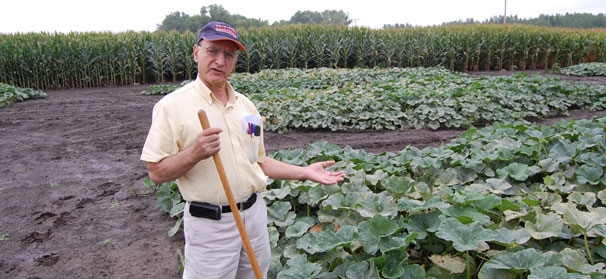

Oct 19, 2012Processing pumpkins boost illinois acreage
For growers around Morton, Ill., the so-called Pumpkin Capital of the World, fall is a very busy time of year, said Mohammad Babadoost, a researcher with the University of Illinois who studies pumpkins and other crops. Much of the state’s pumpkin crop is grown within 90 miles of Morton.
“The Morton area relies on pumpkins,” he said. “Around 90 percent, maybe over 90 percent of the processed pumpkins in the country are grown and processed here.”
With help from Morton, the home of Libby’s Pumpkin – which processes 85 percent of the canned pumpkin sold in the world – the state of Illinois leads the country in pumpkin production. According to USDA, there were 17,400 acres of pumpkins in production in Illinois last year, a large chunk of the 47,300 acres nationwide. Illinois acres grew from 14,300 in 2009. The industry is growing, Babadoost said.
Most of that acreage is in processing pumpkins, with Dickenson being the top variety. About six years ago, Babadoost said, there were more jack-o-lantern pumpkins planted, but now processing pumpkins account for 60 percent of the total crop. Jack-o-lanterns account for the rest. Other top producing states like Michigan, Ohio, Pennsylvania and New York have remained relatively flat in total acreage.
Babadoost said the growth in Illinois is due to several factors. The industry around Morton and the central part of the state, combined with good growing land, is one. He also pointed to strong market demand and a good working relationship with the University of Illinois.
“We do research for various diseases, particularly phytophthora,” Babadoost said. “Maintaining pumpkin plots is very difficult for researchers. They grow very big and require a lot of maintenance”
Disease
Babadoost has been studying disease resistance and controls for the pumpkin industry. Phytophthora blight used to be the main problem, he said, leading to a 100 percent loss of the crop in some years. Currently, those losses average around 10 percent, he said.
“The losses may go as high as 20 percent in some areas, but for the most part, the losses stay around 5 to 10 percent,” he said. “It hasn’t been too bad this year due to the drought. The dry conditions have kept some diseases at bay.”
The reduction of phytophthora blight in central Illinois is part of the state’s success story, Babadoost said.
New on the scene is a Xanthomonas bacteria disease that is affecting central Illinois and the north-central region. It is affecting pumpkins and winter squash, and there is no good control measure yet, Babadoost said.
The cooperation between growers and the processing industry has made both successful. It also helps Babadoost’s research. Growers provide good amounts of land for test plots and help with maintenance, he said.
By Derrek Sigler, Assistant Editor














